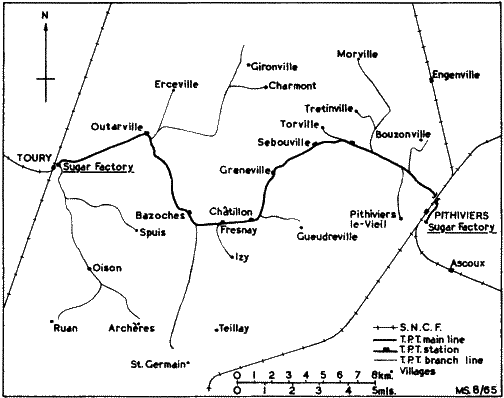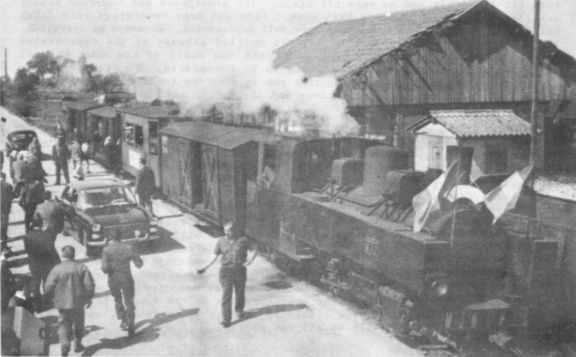
| THE INDUSTRIAL RAILWAY RECORD |
© SEPTEMBER 1965 |
LAST TRAIN TO TOURY
VIC J. BRADLEY
(Photograph by the Author)
Like a disastrous thunderbolt out of a peaceful blue sky, the news reached England early this year that the Tramway Pithiviers-Toury had closed. People shook their heads and said it could not be - this 2ft gauge French rural roadside railway, with its varied stock of ancient steam locomotives, its enthusiastic management and its huge sugar beet traffic, had blackened the skies of the Beauce with briquette smoke for many years past and must surely continue to do so for many years to come.
Alas, the news was true. Yet another, and very nearly the last, of the once prolific 6ocm gauge lines of France‘s northern sugar fields had decided to drop its fires in favour of road transport. The official date of closure was 31st December 1964 but such was the extent of the system, with its lengthy cross-country branch lines to remote farms totalling more than three times its main line mileage, that six months after closure the line was still as open as ever. True, some of the branches had been removed, but many miles still remained to be dealt with, and the main line was intact and still in frequent use. The locomotive and rolling stock position was as it was prior to closure, with the exception of a van or two, their bodies having been sold to farms for use as sheds.
Thus it was that on Saturday 22nd May 1965 our affiliated society, the Federation des Amis des Chemins de Fer Secondaires, were able to arrange for the running of a farewell passenger train over the T.P.T., and thus it also was that, after receiving an urgent message from Noel Needle, and having made a hectic dash across the Channel, I found myself travelling across the green fields of Loiret in one of those curious S.N.C.F. railcars which have conning towers for the drivers, and bogies whose axles are placed much closer together than the gauge of the track.
Saturday morning was spent exploring the T.P.T. sheds and goods yard, which are located on a rather cramped and narrow strip of land between the S.N.C.F. and a road. Although it was obvious that some tidying up of derelict machinery had taken place since M.H.Billington visited the line in 1962 (see RECORD No.2 there were still no less than fourteen steam locomotives present, in addition to the 2−6−0 diesel loco., and the peculiar petrol electric railcar. Of the steam stock, there were no less than six 0−6−0T, two of which were only obtained recently and had not been put into service when closure came. The remainder of the stock comprised one 0−10−0T, two 0−6−0T, one Mallet 0−4−4−0T, a 4−6−0P by Hunslet (of similar appearance to the illustration on page 82 of RECORD No.3) and finally three 2−6−2T built by Alco - these latter are the nearest thing one can see to an "Ashover" type Baldwin this side of Turkey.


T.P.T. No.4−12 (Franco-Belge 2843 of 1944)
During the morning more and more enthusiasts descended on the sleepy town and many occupied their time by cleaning the special train drawn up in the yard, which comprised 0−8−0T No.4.12, the railcar (run out of gear and used as a coach) and three bogie goods vans. In due course the locomotive was decorated with flags and flowers, noticeboards were nailed to the rolling stock and more flags were hung on the last vehicle. Soon the time to depart approached, and after a lengthy speech by the manager, roughly half of the crowd crushed themselves into the train and off we went. Down past the locomotive sheds, under the S.N.C.F., over a level crossing and away into the foot high grass which completely hid the rails. Those who were not travelling on the train pursued it by motor coach, car, scooter or moped, one energetic chap following it all the way by pedal cycle!
Speed was maintained at a steady 15 to 20 m.p.h., the route being lined by hordes of photographers, the clicking of their cameras almost drowning the explosions of the detonators placed on the line. A short stop was made at Greneville after which we continued to Bazoches-les-Gallerandes, the ultimate destination for our train. Not, as the driver went to great pains to explain, that we couldn’t have got to Toury had we wished to; it was just that time did not permit the full journey.
They turned the locomotive on a turntable that looked far too short, while we wandered around and noticed the contents of a goods wagon being transhipped to a farm trailer; evidently some freight traffic was still being worked despite closure! Soon a plaintive blast on the engine‘s hooter caused a mad rush for the train and we were off again. The atmosphere was somewhat sadder now, for this really was the last time. Film and tape recordings were taken for television, and the newspapers were well represented. Homeward we travelled, the rhythmic rattling of the wheels, the muffled exhaust of the superheated locomotive, the clicking of the cameras and the smell of new mown hay all combining to create an atmosphere long to be remembered. We stopped in the woods for some final photographs, then ran on down the roadside to Pithiviers, where the train was soon shunted away and the T.P.T. said goodbye to its last farepaying passenger.
What of the future? Well of course for the T.P.T. there is no future, though no doubt there will be locomotives at Pithiviers for another twelve months at least. And after that? Who knows? Perhaps in years to come the lone enthusiast will, in a farmyard or a field, discover a rotting wagon chassis with a cast iron plate reading "Property of U.S.Government" and he will gaze at a narrow clearing through a coppice and mourn what he has missed. But many items from the T.P.T. will live for ever − at least one locomotive is to go to the Malakoff Museum and no doubt others will go to the enthusiast operated C.F.T.M. near Lyons. The Hunslet will almost certainly return to England, and certain Welsh narrow gauge lines are understood to be interested in some of the other locomotives. Even a few of the wagon bogies have gone to Cap Feret, but at Pithiviers - there will only be memories and perhaps a few postcards still available from the photographers in the town. The Beauce is a desolate windswept place with little to attract the stranger, and with the passing of the T.P.T. it will be all the poorer.